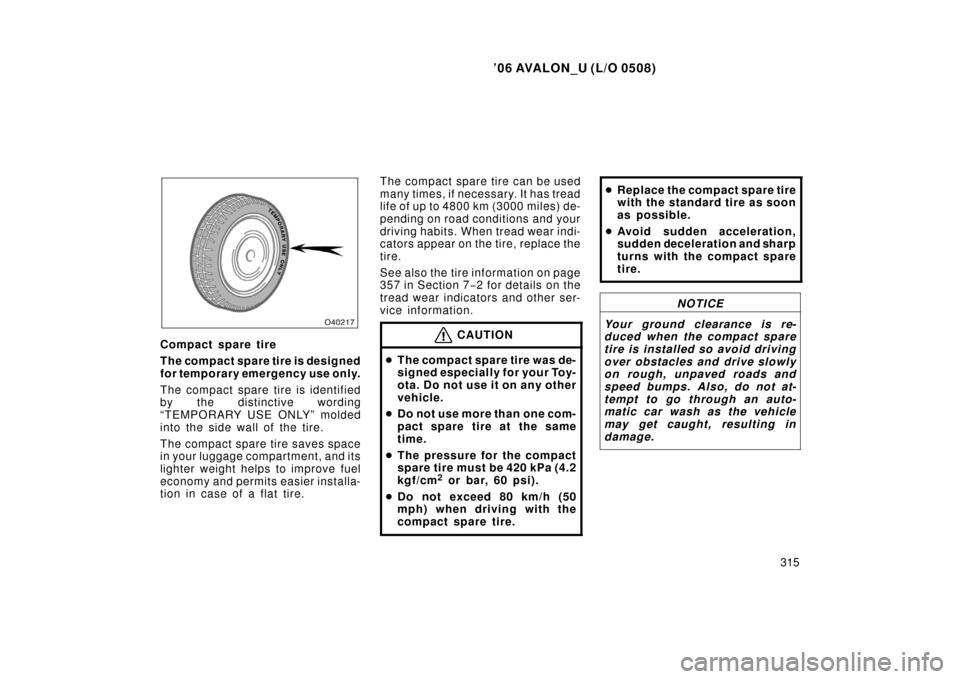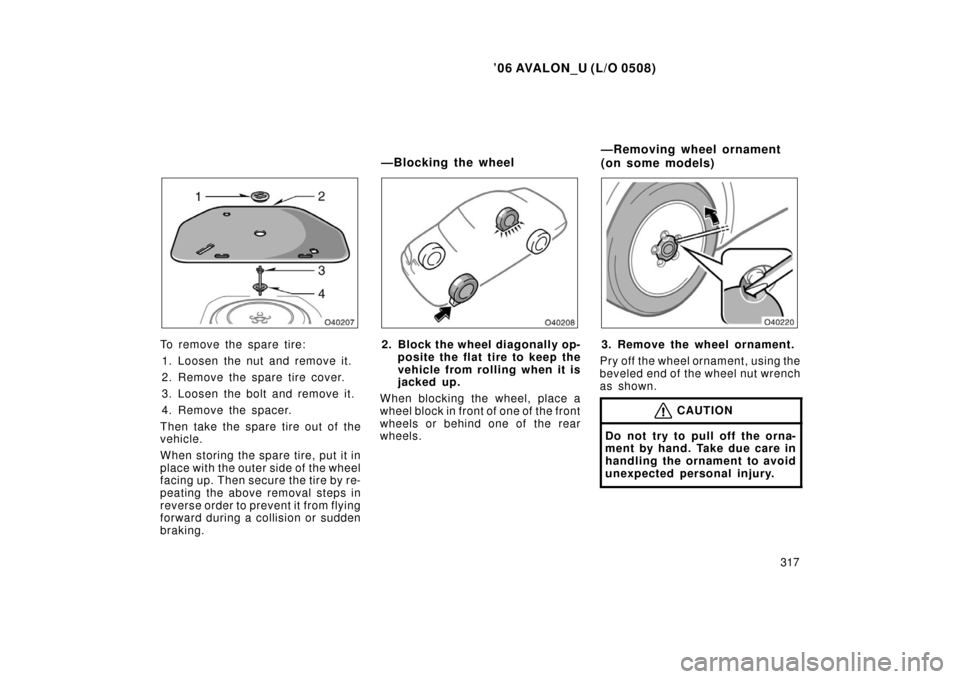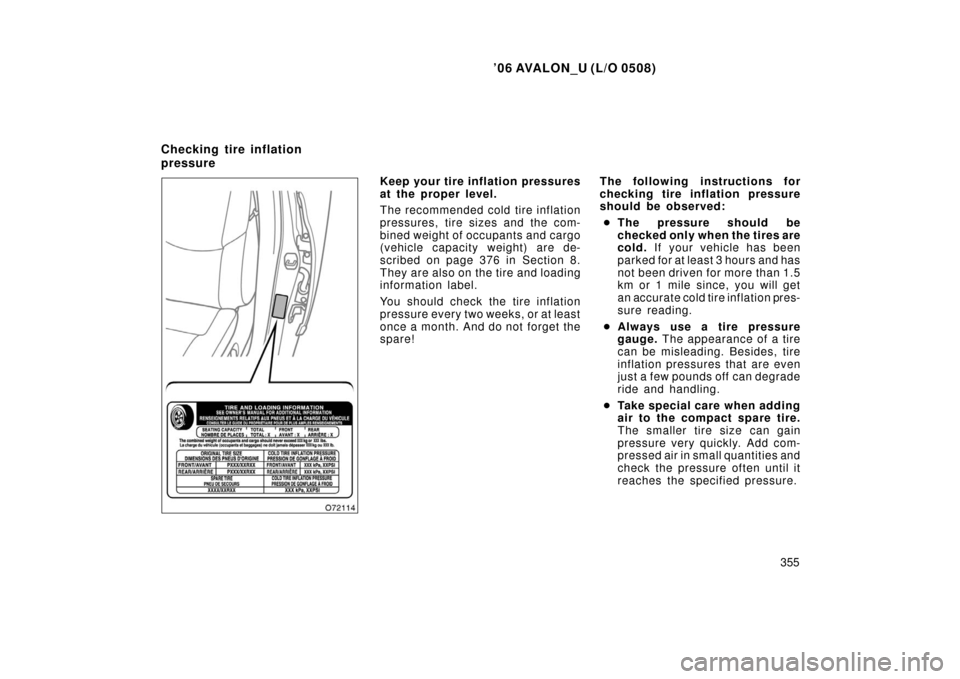Page 283 of 398
’06 AVALON_U (L/O 0508)
275
This illustration indicates typical tire
symbols.
1. “TEMPORARY USE ONLY”— A
compact spare tire is identified by
the phrase “TEMPORARY USE
ONLY” molded into its sidewall.
This tire is designed for temporary
emergency use only. For details,
see “Compact spare tire” on page
315.
2. Tire size— F or det ails, see “— Ti re
size” on page 277.
3. DOT and Tire Identification Number (TIN)— For details, see
“—DOT and Tire Identification
Number (TIN)” on page 276.
4. The location of the tread wear indicators— For details, see
“Checking and replacing tires” on
page 357.
5. Load limit at maximum cold tire inflation pressure— For details,
see “Checking and replacing tires”
on page 357.
—Tire symbols (compact spare tire)
Page 323 of 398

’06 AVALON_U (L/O 0508)
315
Compact spare tire
The compact spare tire is designed
for temporary emergency use only.
The compact spare tire is identified
by the distinctive wording
“TEMPORARY USE ONLY” molded
into the side wall of the tire.
The compact spare tire saves space
in your luggage compartment, and its
lighter weight helps to improve fuel
economy and permits easier installa-
tion in case of a flat tire.The compact spare tire can be used
many times, if necessary. It has tread
life of up to 4800 km (3000 miles) de-
pending on road conditions and your
driving habits. When tread wear indi-
cators appear on the tire, replace the
tire.
See also the tire information on page
357 in Section 7−
2 for details on the
tread wear indicators and other ser-
vice information.CAUTION
� The compact spare tire was de-
signed especially for your Toy-
ota. Do not use it on any other
vehicle.
� Do not use more than one com-
pact spare tire at the same
time.
� The pressure for the compact
spare tire must be 420 kPa (4.2
kgf/cm
2 or bar, 60 psi).
� Do not exceed 80 km/h (50
mph) when driving with the
compact spare tire.
�Replace the compact spare tire
with the standard tire as soon
as possible.
� Avoid sudden a cceleration,
sudden d eceleration and sharp
turns with the compact spare
tire.
NOTICE
Your ground clearance is re-
duced when the compact spare
tire is installed so avoid driving
over obstacles and drive slowly
on rough, unpaved roads and
speed bumps. Also, do not at-
tempt to go through an auto-
matic car wash as the vehicle
may get caught, resulting in
damage.
Page 324 of 398
’06 AVALON_U (L/O 0508)
316
1. Get the required tools andspare tire.
1. Jack handle
2. Wheel nut wrench
3. Jack
4. Spare tire
To prepare yourself for an emergency,
you should familiarize yourself with
the use of the jack, each of the tools
and their storage locations.To remove the jack, turn the jack joint
by hand until the jack becomes free.To st or e the jac k , align the hole o f t he
jack head with the vehicle hook. Turn
the jack joint until the jack base fits
securely with the vehicle body.
This prevents the jack from flying for-
ward during a collision or sudden
stop.
—Required tools and spare
tire
Page 325 of 398

’06 AVALON_U (L/O 0508)
317
To remove the spare tire:1. Loosen the nut and remove it.
2. Remove the spare tire cover.
3. Loosen the bolt and remove it.
4. Remove the spacer.
Then take the spare tire out of the
vehicle.
When storing the spare tire, put it in
place with the outer side of the wheel
facing up. Then secure the tire by re-
peating the above removal steps in
reverse order to prevent it from flying
forward during a collision or sudden
braking.2. Block the wheel diagonally op- posite the flat tire to keep the
vehicle from rolling when it is
jacked up.
When blocking the wheel, place a
wheel block in front of one of the front
wheels or behind one of the rear
wheels.3. Remove the wheel ornament.
Pry off the wheel ornament, using the
beveled end of the wheel nut wrench
as shown.
CAUTION
Do not try to pull off the orna-
ment by hand. Take due care in
handling the ornament to avoid
unexpected personal injury.
—Blocking the wheel —Removing wheel ornament
(on some models)
Page 327 of 398
’06 AVALON_U (L/O 0508)
319
6. After making sure that no oneis in the vehicle, raise it high
enough so that the spare tire
can be installed.
Remember you will need more ground
clearance when putting on the spare
tire than when removing the flat tire.
To raise the vehicl e, insert the jack
handle into the jack (it is a loose fit)
and turn it clockwise. As the jack
touches the vehicle and begins to lift,
double −check that it is properly posi-
tioned.
CAUTION
Never get under the vehicle when
the vehicle is supported by the
jack alone.
7. Remove the wheel nuts and change tires.
Lift the flat tire straight off and put it
aside.
Roll the spare wheel into position and
align the holes in the wheel with the
bolts. Then lift up the wheel and get
at least the top bolt started through
its hole. Wiggle the tire and press it
back over the other bolts.
—Raising your vehicle —Changing wheels
Page 330 of 398

’06 AVALON_U (L/O 0508)
322
CAUTION
�Take due care in handling the
ornament to avoid unexpected
personal injury.
� Do not attach a heavily dam-
aged plastic wheel ornament.
It may fly off the wheel and
cause accidents while the ve-
hicle is moving.
11. Check the air pressure of the re-
placed tire.
Adjust the air pressu re to the specifi-
cation designated on page 380 in
Section 8. If the pressure is lower,
drive slowly to the nearest service
station and fill to the correct pressure.
Do not forget to reinstall the tire infla-
tion valve cap as dirt and moisture
could get into th e valve core and
possibly cause air leakage. If the cap
is missing, have a new one put on as
soon as possible.
12.Restow all the tools, jack and flat tire securely.
As soon after changing wheels as
possible, tighten the wheel nuts to the
torque specified on page 380 in Sec-
tion 8 with a torque wrench. Have a
technician repair the flat tire and re-
place the spare tire with it.CAUTION
Before driving, make sure all the
tools, jack and flat tire are se-
curely in place in their storage
location to reduce the possibility
of personal injury during a colli-
sion or sudden braking.
—After changing wheels
Page 363 of 398

’06 AVALON_U (L/O 0508)
355
Keep your tire inflation pressures
at the proper level.
The recommended cold tire inflation
pressures, tire sizes and the com-
bined weight of occupants and cargo
(vehicle capacity weight) are de-
scribed on page 376 in Section 8.
They are also on the tire and loading
information label.
You should check the tire inflation
pressure every two weeks, or at least
once a month. And do not forget the
spare! The following instructions for
checking tire inflation pressure
should be observed:
� The pressure s hould be
checked only when the tires are
cold. If your vehicle has been
parked for at least 3 hours and has
not been driven for more than 1.5
km or 1 mile since, you will get
an accurate cold tire inflation pres-
sure reading.
� Always use a tire pressure
gauge. The appearance of a tire
can be misleading. Besides, tire
inflation pressures that are even
just a few pounds off can degrade
ride and handling.
� Take special care when adding
air to the compact spare tire.
The smaller tire size can gain
pressure very qu ickly. Add com-
pressed air in small quantities and
check the pressure often until it
reaches the specified pressure.
Checking tire inflation
pressure
Page 366 of 398

’06 AVALON_U (L/O 0508)
358 The tires on your Toyota have built−in
tread wear indicators to help you
know when the tires need replace-
ment. When the tread depth wears to
1.6 mm (0.06 in.) or less, the indica-
tors will appear. If you can see the
indicators in two or more adjacent
grooves, the tire should be replaced.
The lower the tread, the higher the
risk of skidding.
The effectiveness of snow tires is
lost if the tread wears down below
4 mm (0.16 in.).
If you have tire damage such as
cuts, splits, cracks deep e nough to
expose the fabric, or bulges indi-
cating internal damage, the tire
should be repl aced.
If a tire often goes flat or cannot be
properly repaired due to the size or
location of a cut or other damage, it
should be replaced. If you are not
sure, consult with your Toyota dealer. If air loss occurs while driving, do not
continue driving. Driving even a short
distance can damage a tire beyond
repair.
An y ti res wh i ch are over 6 years
old must be checked by a qualified
technician even if damage is not
obvious.
Tires deteriorate with age even if they
have never or seldom been used.
This applies also to the spare tire and
tires stored for future use.
REPLACING YOUR TIRES
When replacing a tire, use a tire of
the same size and construction,
and the same or greater maximum
load as the originally installed
tires.
Using any other size or type of tire
may seriously affect handling, ride,
speedometer/odometer calibration,
ground clearance, and clearance be-
tween the body and tires or snow
chains.
Check that the maximum load of the
replaced tire is greater than 1/2 of the
Gross Axle Weight Ratings (GAWR)
of either the front axle or the rear
axle, whichever is greater. As for the
maximum load of the tire, see the load
limit at maximum cold tire inflation
pressure mentioned on the sidewall
of the tire, and as for the Gross Axle
Weight Ratings (GAWR), see the Cer-
tification Label.
For details about the side wall of the
tire and the Certification Label, see
pages 271 and 273.